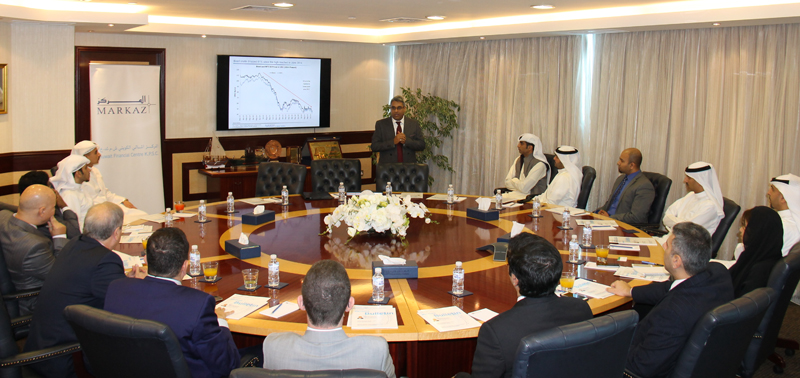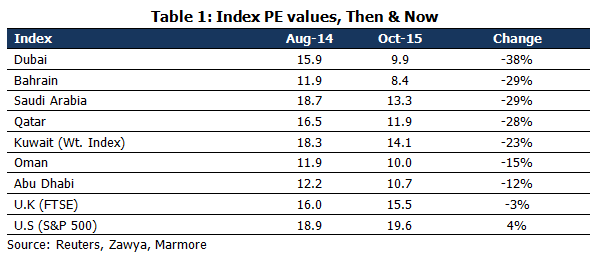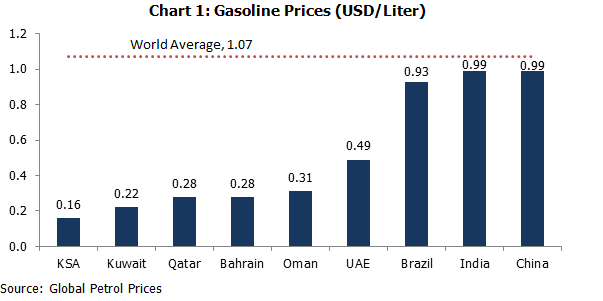The Kuwait Financial Center "Markaz" recently conducted, in cooperation with the Kuwait Banks Association, an introductory presentation entitled "Liquidity in the Gulf Cooperation Council Countries and its Impact on Banks, Stock Markets and Bond Markets". The presentation was made by Mr. M. NS. Raghu, Senior Vice President of Research at Markaz and Managing Director of Marmore MENA Intelligence, a Markaz-owned subsidiary that provides integrated research and financial analysis services to the economies and markets of the Middle East and North Africa region.

Mr. Raghu indicated that the impact of the recent decline in oil prices, which has exceeded 61% since June 2014, as a result of many factors, including the shale oil revolution in the United States, and OPEC's decision to maintain its production levels despite signs of weak demand growth, has extended to affect The Gulf financial system through banking channels, which led to sudden increases in the one-day lending interest rate.
Mr. Raghu added that the GCC countries are still largely dependent on oil revenues, despite their efforts to diversify their economies. The International Monetary Fund expects that the oil export revenues in the Gulf Cooperation Council countries will decline by a total of 250 billion US dollars in 2015 compared to what they were in 2014. With the oil price currently below the oil break-even price, it is expected that the fiscal surplus of the GCC countries will shift The Gulf Cooperation Council, which represented 4.6% of GDP in 2014, led to a deficit of about 7.9% of GDP in 2015. Although the Gulf governments have largely maintained the levels of spending their budgets in 2015 to ensure the continuation of their economic growth In the medium term, however, fiscal reforms are a must.
He also explained that in light of the drastic changes in the financial situation and the decline in oil prices, Gulf governments could be forced to reassess their spending patterns. However, the low levels of public debt in the countries of the Gulf Cooperation Council, which amounts to 9% of GDP, compared to 117% of GDP in the G7 countries, and the higher sovereign ratings of most Gulf countries, make the prevailing conditions in the region reassuring in the long run. short.
In light of the expectation of most international bodies such as the International Monetary Fund, the World Bank and major investment banks (JP Morgan and Goldman Sachs) for the continuation of the climate of declining oil prices, the Gulf governments began to develop multiple strategies to confront the deficit, including liquidating some of the investments they own through their sovereign funds. Last year, Saudi Arabia withdrew more than $70 billion from its reserves. In addition, governments in all countries of the Arab Gulf region have begun to reduce their non-essential spending and are working to confront the growing problem of subsidies.
Mr. Raghu added that the decline in oil revenues has clearly affected the movement of deposits in Gulf banks, as government deposits constitute a large proportion of total bank deposits. The decline in deposit growth, along with governments withdrawing their savings, has created short-term pressures in the money market. Despite the quality of banks' capital, they may not be able to turn into the only source of government financing.
In addition, stock markets have fallen over the past year, affected by the decline in crude oil prices. With Gulf companies expected to have lower profits in the near term, and insufficient bank lending to invest in the stock markets, stocks in the GCC could face further pressures. Share values, according to the P/E ratio, in the Gulf markets have declined on average by 25% since the second quarter of 2014. Global bond issuances from the Gulf Cooperation Council countries (corporate bonds and sovereign bonds) also decreased by 33% compared to what they were a year ago, to reach 22 $1 billion in the first nine months of 2015, the lowest level in any nine-month period since 2008.
On the other hand, additional financing methods can be adopted, such as the local and international debt markets. For the first time in the last eight years, Saudi Arabia borrowed about $27 billion from the domestic debt market. The Gulf countries are currently studying on a large scale a number of measures to increase their revenues, for example the introduction of value-added tax. The International Monetary Fund recommends the imposition of taxes in a phased manner.
Although interest rates have fallen to unprecedented low levels, relatively high sovereign ratings, low levels of debt and an increase in the opportunity cost of SWFs, justify the tendency to borrow to meet the deficit rather than liquidate the assets of SWFs, Mr. Raghu sees the need for careful follow-up over the months The upcoming decisions of Gulf governments and their impact on the financial system in general. Mr. Raghu also expected that continued pressures on liquidity would accelerate the implementation of long-awaited reforms in the Gulf region, leading to long-term improvement.



About the Kuwait Financial Center "Markaz"
The Kuwait Financial Center (KSC) "Markaz" was established in 1974 to become one of the reputable financial institutions in the Arab Gulf region in the fields of asset management and investment banking. The center now manages total assets of 1.05 billion Kuwaiti dinars as of September 30, 2015 (US$3.47 billion). Markaz was listed on the Kuwait Stock Exchange in 1997.
For more information, please contact:
Osama Zaid Al-Musallam
Marketing and Public Relations Department,
Kuwait Financial Center Company “Markaz”
Tel: 22248000 Ext: 1819
Direct: 8075 2224
Fax: 22498740
[email protected]

